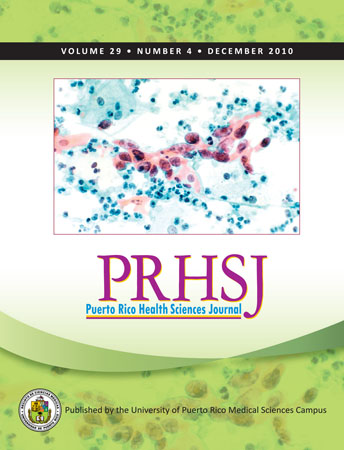Abstract
Objective: The participation of Puerto Rico in the Latin American Vertebral Osteoporosis Study (LAVOS) has allowed us to study the magnitude of the problem of osteoporosis in the female population residing in San Juan. The objective of LAVOS was to estimate the prevalence of vertebral fractures in Latin American women using a random sample of females selected from cities across five Latin American countries. Methods: A probability cluster design was employed to select a random sample of households in San Juan, Puerto Rico, in order to interview 400 females aged 50 years and over. A 30-minute face-to-face interview gathered data on demographics, risk factors, and life styles. Data regarding bone mineral densities of the spine and hip by DXA and lateral dorsolumbar X-rays were obtained using international protocols; digital morphometry was used to determine vertebral deformities, with the results being classified according to Eastell criteria. This article summarizes the main findings observed in San Juan, Puerto Rico. Results: Overall weighted prevalence of vertebral fractures was 11.2% (95% CI: 8.5%, 14.7%). Age-specific prevalence of vertebral fractures was as follows: 5.4% (95% CI: 2.7%, 10.7%) in the 50-59 years age group, 8.3% (95% CI: 4.4%, 15.1%) in the 60-69 years group, 16.2% (95% CI: 10.5%, 25.0%) in the 70-79 years group, and 22.4% (95% CI: 13.3%, 35.1%) in participants ? 80 years. Factors significantly associated with vertebral fractures were being 70-79 years old (adjusted POR70-79 vs. 50-59 = 2.9; 95% CI: 1.1, 7.4), being ? 80 years old (adjusted POR > 80 vs. 50-59 = 3.3; 95% CI: 1.2, 9.4), and a T-score ? -2.5 in the lumbar spine (adjusted POR = 2.5; 95% CI: 1.5, 5.7) and in the femoral neck (adjusted POR = 3.5; 95% CI: 1.5, 8.0). Personal history of fractures was marginally associated with vertebral fractures after adjusting for the remaining risk factors (adjusted POR = 2.0; 95% CI: 1.0, 4.0). Nearly 94% of the women with vertebral fractures were not aware of their bone status. Using the WHO classification, we determined that 71% had osteoporosis, 21%, osteopenia, and 8%, normal bone mineral densities. Bone mineral densities in the lumbar spine and femoral neck were significantly lower in women with vertebral fractures. Non-vertebral fractures were more common in women with a personal history of prior vertebral fractures. The prevalence of the most common non-vertebral fractures were hip, 1% (95% CI: 0.4%, 2.7%), and wrist, 5.9% (95% CI: 4.0%, 8.7%), respectively. Conclusion: This is the first population-based study of osteoporotic fractures in Puerto Rico and should serve as a guide to health providers and policy makers in the prevention and treatment of this disease.
Authors who publish with this journal agree to the following terms:
a. Authors retain copyright and grant the journal right of first publication with the work simultaneously licensed under a Creative Commons Attribution License that allows others to share the work with an acknowledgement of the work's authorship and initial publication in this journal.
b. Authors are able to enter into separate, additional contractual arrangements for the non-exclusive distribution of the journal's published version of the work (e.g., post it to an institutional repository or publish it in a book), with an acknowledgement of its initial publication in this journal.
c. Authors are permitted and encouraged to post their work online (e.g., in institutional repositories or on their website) prior to and during the submission process, as it can lead to productive exchanges, as well as earlier and greater citation of published work (See The Effect of Open Access).
